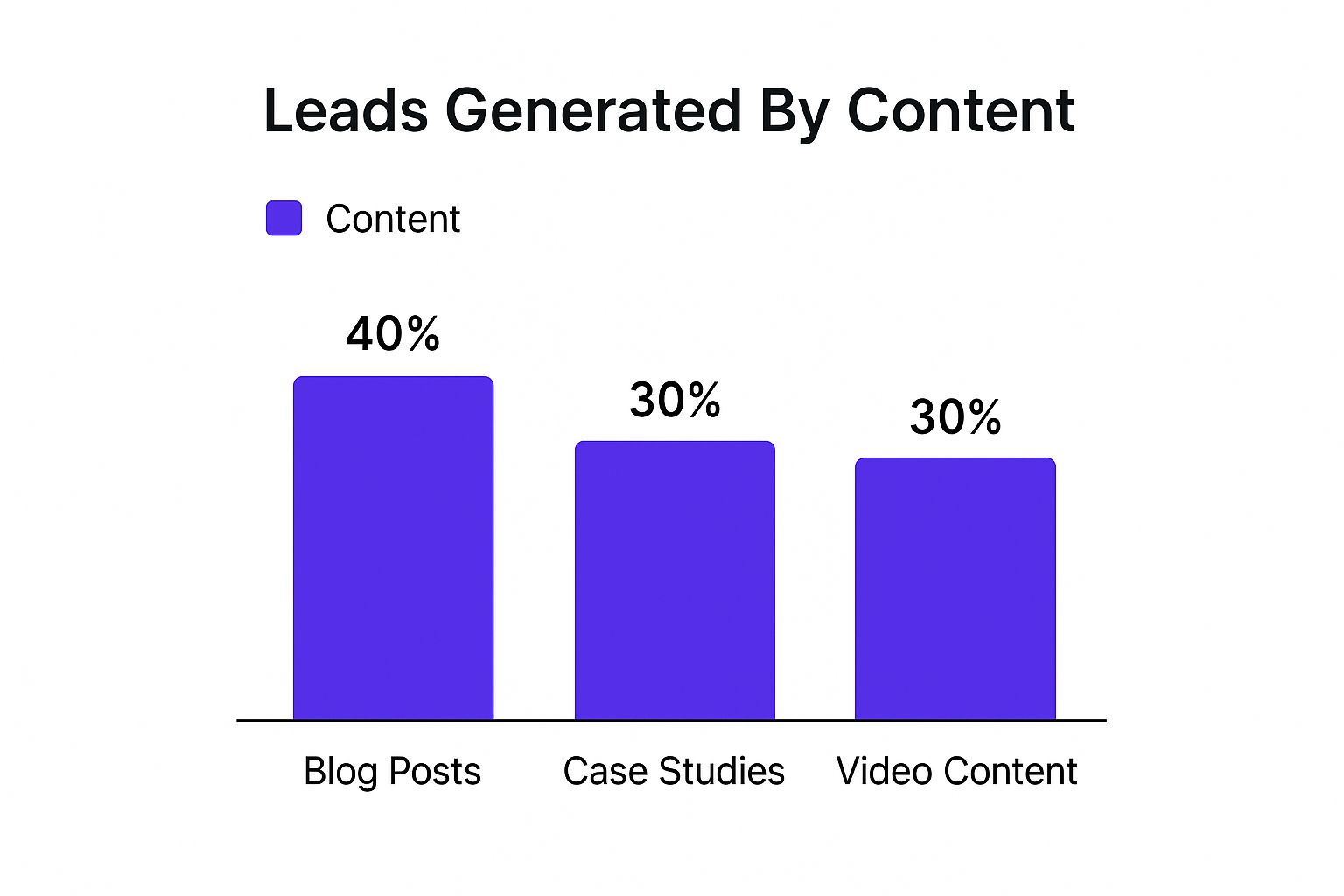For too long, many construction companies have gotten by on word-of-mouth and a solid reputation. While those things still matter, they’re no longer enough to guarantee a steady stream of high-value projects. A real marketing strategy for a construction company is about building a powerful, trusted brand that consistently puts you in front of the right clients.
It's a deliberate shift from waiting for the phone to ring to making it ring. This means figuring out who your most profitable clients are, crafting a message that sets you apart, and showing up where they’re looking—whether that’s online or on-site. In today's competitive market, this isn't just a good idea; it's essential for long-term growth.
Building Your Modern Marketing Blueprint

Relying on your portfolio and past successes alone won't cut it anymore. The construction world is changing, and your marketing has to keep up. You need a well-defined blueprint that guides every decision you make, from the jobs you bid on to the stories you tell about your work.
Think of this guide as the foundation for that blueprint. We're moving beyond basic lead generation to focus on building a brand that commands respect and attracts the kind of projects that actually grow your bottom line. To do this right, it’s worth exploring some powerful small business marketing strategies and figuring out how to adapt them for the unique demands of our industry.
Core Pillars of Your Strategy
A strong marketing plan isn't a random collection of activities; it’s a cohesive system built on a few key pillars. Each one has a specific job to do, working together to turn prospects into profitable, long-term clients.
- Audience and Niche Identification: This is about zeroing in on your most profitable client base and maybe even specializing in a particular market segment. Who do you really want to work with?
- Compelling Value Proposition: You need to clearly and confidently answer the question: "Why should we hire you over anyone else?"
- Strategic Channel Selection: It's all about choosing the right marketing channels—both online and offline—to get your message in front of your ideal clients.
- Performance Tracking and Optimization: This means using real data to measure what's working, what's not, and constantly tweaking your approach for better results.
A proactive marketing strategy is no longer a luxury; it's a necessity for survival and growth. It's the system that ensures your sales pipeline remains full, even when referral business slows down.
The opportunity here is massive. The global construction industry is on track to hit a market size of $20.44 trillion by 2029, thanks to growing cities and huge infrastructure projects. That kind of growth creates incredible opportunities for firms that have a solid marketing plan ready to go. You can read more on this projected industry growth.
Ultimately, every single marketing effort should feed into a structured process that guides potential clients from their first impression to a signed contract. Managing that journey is what separates the top players from everyone else. In fact, if you want to dive deeper into that process, our guide on what sales pipeline management is shows exactly how it can transform your lead conversion rates.
Now, let's tie these foundational concepts together.
Core Pillars of Your Construction Marketing Blueprint
This table breaks down the essential components we've just discussed, giving you a clear snapshot of what a robust marketing strategy looks like in action.
| Pillar | Objective | Key Actions |
|---|---|---|
| Audience & Niche | Define and attract your ideal, most profitable clients. | Conduct market research, create buyer personas, and analyze past project profitability. |
| Value Proposition | Differentiate your firm from the competition. | Identify unique strengths, craft a compelling brand message, and create a strong tagline. |
| Channel Selection | Reach your target audience where they are most active. | Evaluate digital (SEO, social media) and traditional (events, print) channels for ROI. |
| Performance Tracking | Measure success and optimize for better results. | Set KPIs, use analytics tools (e.g., Google Analytics), and regularly review campaign data. |
Think of this table as your quick-reference checklist. As you build out your plan, keep coming back to these four pillars to ensure every part of your strategy is strong, focused, and aligned with your business goals.
Finding Your Niche and Crafting a Powerful Message
Trying to be the go-to builder for everyone is one of the fastest ways to get lost in the noise. A truly effective marketing strategy doesn't start with a wide net; it starts with a sharp focus. You need to pinpoint the exact market segment where your skills, experience, and passion deliver the most value.
This isn’t about listing everything you can do. It's about owning what you do best. Are you the crew that masterfully navigates the red tape of historical renovations? Or maybe your team is unbeatable when it comes to the fast-paced, high-precision world of commercial tenant improvements. Being a generalist makes you a commodity. A specialist is an expert.
Analyze Your Past Projects to Find Your Sweet Spot
The clues to your ideal niche are probably buried in your existing project files. Take a hard look at the jobs you’ve completed over the last two to three years, but don’t just glance at the final profit margin. You're looking for patterns.
Ask yourself a few honest questions:
- Where did we make the most money? Go beyond revenue and look at actual profit. Certain job types consistently yield better margins.
- Which projects were the least painful? Think about the ones with fewer change orders, seamless communication, and genuinely great client relationships.
- Who were our best clients? Were they homeowners who appreciated fine craftsmanship, or commercial developers obsessed with ROI?
- What complex problems did we solve? Dig into the projects where your team's unique problem-solving abilities really made a difference.
This kind of analysis often turns up surprising insights. You might realize that while you're perfectly capable of doing residential additions, your most profitable and enjoyable work comes from building specialized medical office facilities. That's your niche calling.
Define Your Unique Value Proposition
Once you know who you’re talking to, you have to give them a rock-solid reason to choose you. Let's be clear: "on time and on budget" is not a unique value proposition (UVP). It’s the table stakes—the bare minimum every client expects. Your UVP has to cut deeper and speak directly to the specific pains and ambitions of your ideal customer.
Your value proposition is the promise you make. It must answer one simple question for a potential client: "Why should I hire you over every other contractor?"
Let's say your niche is building high-end custom homes for discerning families. Your value isn't just in the quality of the build; it’s in the entire experience.
Generic Statement: "We build high-quality custom homes."
Powerful UVP: "We partner with families to create architecturally significant homes through a transparent, collaborative process that eliminates stress and delivers a predictable, enjoyable building experience."
See the difference? The second version connects on an emotional level. It directly addresses the client's biggest fear—a stressful, chaotic build—and promises a specific, desirable outcome that goes far beyond the physical house. It frames you as a trusted partner, not just a builder for hire.
Turn Your UVP into a Compelling Brand Story
Your UVP is the heart of your brand message, and it needs to beat in every single piece of your marketing. It should be on your website's homepage, in your social media posts, and front-and-center in your proposals. This consistency is how you build a brand that people remember and trust.
Think about the proof. How do you show you live up to this promise? Is it through detailed case studies that break down how you navigated a tricky project? Or is it through client testimonials that rave about your team's communication? Your brand story is the collection of evidence that proves your UVP is the real deal.
A commercial contractor specializing in restaurant build-outs isn't just telling a story about finishing on schedule. They’re talking about understanding the immense pressure of opening day. They’re showcasing how they build spaces that boost a restaurant's operational efficiency and enhance the customer experience. A smart marketing strategy for a construction company in that niche would be packed with stories of helping restaurateurs open their doors faster and run more profitably. This is the kind of focused messaging that attracts the right clients and makes every marketing dollar work harder.
Building Your Digital Foundation and Authority

Let's be blunt: in the construction world, your digital presence has become your new storefront, your sales pitch, and your portfolio, all in one. Potential clients don't just take a referral at face value anymore. Their first move is to Google your company, scrutinize your past work, and see what others are saying. A weak or nonexistent online footprint is a huge red flag that sends high-value leads running straight to your competition.
Building a solid digital presence is a cornerstone of any effective marketing strategy for a construction company. This isn't about having a flashy website that just looks pretty. It's about engineering a powerful, lead-generating machine that establishes your firm as a credible, authoritative voice in your market.
Your Website: The Hub of Your Marketing Universe
Think of your website as the central command for all your marketing efforts. It's the one piece of digital real estate you completely own and control. Every ad, social media post, and email you send should ultimately point people back to a professional, well-designed site.
For a construction business, a website has to do more than just list services. It needs to build instant trust and make it ridiculously easy for a prospect to take the next step.
Here’s what every high-performing construction website needs:
- A Mobile-First Design: More than half of all web traffic now comes from smartphones. If your site is a pain to navigate on a phone, you're losing leads. Text must be easy to read and buttons must be easy to tap.
- A Stunning Visual Portfolio: High-quality photos and videos of your finished projects are non-negotiable. This is where you show—not just tell—the quality of your work.
- Crystal-Clear Calls-to-Action (CTAs): Don't make people hunt for how to contact you. Prominent buttons like "Request a Consultation" or "See Our Projects" should be impossible to miss on every single page.
- Authentic Client Testimonials: Social proof is incredibly powerful. Featuring quotes and stories from happy clients builds the credibility needed to overcome a prospect's natural hesitation.
Dominate Your Local Market with Local SEO
For most contractors, the battle for new business is won or lost right in your own backyard. This is where Local Search Engine Optimization (SEO) becomes your secret weapon. Local SEO is all about optimizing your online presence to show up when potential customers in your area are searching for the services you offer.
The absolute cornerstone of this effort is your Google Business Profile (GBP). This free listing is what pops up in Google Maps and the "Map Pack" results when someone searches for terms like "commercial contractor near me."
A well-optimized Google Business Profile is arguably the single most impactful free marketing tool for any construction company. It gives you visibility, credibility, and a direct line for new leads to find you.
To get your GBP working for you, you need to:
- Claim and Verify Your Listing: First things first, make sure every detail is 100% accurate, especially your business name, address, and phone number (NAP).
- Choose the Right Categories: Be specific. Don't just pick "Contractor." Use primary and secondary categories that precisely reflect your work, like "Custom Home Builder" or "Commercial Remodeler."
- Upload High-Quality Photos: Constantly add fresh pictures of your team, your equipment, and, most importantly, your completed projects. It keeps your profile active and engaging.
- Actively Manage Your Reviews: Positive reviews are a massive signal to Google and potential clients. Make it easy for satisfied customers to leave feedback, and always respond professionally to all reviews—the good, the bad, and the ugly.
This digital visibility is critical. Just consider that in the U.S. alone, around 1.7 million people search for independent contractors every single month. By optimizing your website and GBP, you ensure you're right there when these motivated buyers are looking. You can discover more insights about contractor marketing statistics to see just how crucial this online presence has become.
Establish Authority by Sharing What You Know
The most successful firms don't just sell their services; they educate their clients. This is where content marketing comes in. It’s how you prove your expertise and build trust long before a prospect is even thinking about signing a contract.
This doesn’t mean you need to become a full-time blogger. It’s about strategically creating content that answers your ideal client's biggest questions and solves their most pressing problems.
A few content ideas that really work for construction firms include:
- Helpful Blog Posts: Write articles that address common homeowner or business owner concerns. Think titles like "What to Expect During a Kitchen Remodel" or "5 Key Considerations for a Commercial Build-Out."
- In-Depth Case Studies: Take a recent success and turn it into a compelling story. Outline the client's initial challenge, the smart solution your team came up with, and the outstanding final results—with plenty of great photos, of course.
- Project Showcase Videos: Nothing brings your work to life like video. A short, well-shot tour of a completed project can be far more impactful than photos alone.
By consistently providing value, you shift from being just another contractor to being a trusted advisor. That change in perception is what turns leads into loyal clients and builds a brand that’s made to last.
Choosing the Right Channels to Reach Your Audience
You’ve defined your niche and hammered out your core message. Now comes the hard part: getting that message in front of the right people. A killer marketing strategy is just a piece of paper if it never reaches your ideal clients. This is where channel selection comes in—choosing the right mix of digital and traditional methods turns your plan into a lead-generating machine.
This isn't about shouting from every rooftop. It's about being strategic. You need to show up where your future clients are already looking for someone just like you. The best strategies I've seen always blend long-term brand building with quick wins that bring in leads now.
Mastering the Digital Job Site
In this market, your digital presence is your new storefront. These channels are powerful because you can target exactly who you want to reach and see precisely what’s working—and what’s not.
Let’s dig into the most effective digital avenues for contractors:
- Search Engine Optimization (SEO): Think of SEO as your long-term investment. It's the craft of getting your website to show up on Google when a potential client types in something like "commercial remodeler in Denver." It takes patience and consistent effort, but a top spot on Google can become a reliable, high-quality source of inbound leads for years to come.
- Pay-Per-Click (PPC) Advertising: Need leads this month? PPC is your answer. With platforms like Google Ads, you can place your company at the very top of the search results for those "money" keywords, like "custom home builder near me." You only pay when someone clicks, and those clicks are often from people who are ready to talk business.
- LinkedIn for B2B Connections: For commercial builders, LinkedIn isn't just social media; it’s a 24/7 networking event. It’s where you’ll find the architects, developers, and property managers you want to work with. Share project updates, post before-and-afters, and weigh in on industry topics to establish your firm as a go-to expert.
The real magic happens when you understand how these tools work together. SEO builds your foundation and long-term authority. PPC is the faucet you can turn on for an immediate flow of leads.
For instance, a residential builder could run a targeted PPC campaign in the spring to capture homeowners planning a summer deck build. At the same time, they could publish a blog post on "choosing the right decking materials" to build their SEO clout. This one-two punch brings in business today while setting them up for a stronger tomorrow.
The Power of Content in Driving Leads
Great content is the fuel for all your digital marketing. It's how you prove you know your stuff and build trust before you've even had a conversation. This chart breaks down how different types of content often perform when it comes to generating real leads.

As you can see, a balanced content diet works best. Blog posts are great for attracting new eyeballs, while detailed case studies and video tours give serious prospects the proof they need to pick up the phone.
Don't Forget Traditional Relationship Building
For all the talk about digital, construction is and always will be a relationship business. Trust is built face-to-face. Overlooking old-school, traditional marketing is a rookie mistake that can cost you some of your best projects.
Here are a few proven tactics that still work wonders:
- Industry Trade Shows and Events: Getting a booth at a local or regional trade show puts you right in the path of potential clients, partners, and top-tier subs. There's no substitute for a firm handshake and the ability to walk someone through your portfolio in person.
- Strategic Networking: Make a point to build genuine relationships with real estate agents, architects, and commercial developers. A referral from a trusted professional is gold. This isn’t a one-time thing—it means grabbing lunch, showing up at local business meetings, and being a visible, active member of your industry community.
- Job Site Marketing: Your current job site is your most effective billboard. Don't waste it. A clean, professional sign with your logo and contact information catches the eye of every neighbor and passerby who might be thinking about their own project.
Marketing Channel Comparison for Construction Companies
So, where should you put your marketing budget? The right answer depends on your specific goals. This table gives you a quick snapshot of how different channels stack up for most construction businesses.
| Channel | Primary Goal | Typical Cost | Best For |
|---|---|---|---|
| Local SEO | Long-term organic leads & authority | Medium (Ongoing effort) | Geographic-focused service businesses. |
| Google Ads (PPC) | Immediate, high-intent lead generation | High (Pay-per-click) | Capturing leads who are actively searching. |
| B2B networking & brand positioning | Low to Medium | Commercial contractors targeting decision-makers. | |
| Trade Shows | In-person relationship building | High (Booth fees & travel) | Making high-value connections with clients & partners. |
A well-rounded marketing strategy will probably pull from a few of these columns. The key is to create a system where your digital marketing fills the pipeline and your in-person networking helps you close the deals. By picking channels that align with your ideal client, you make sure every dollar you spend is working hard to grow your company.
Let Your Work Do the Talking with High-Impact Visuals

Blueprints and spec sheets are essential, but they don't sell a dream. For potential clients, seeing is believing. The real proof is in the finished product, and an effective marketing strategy for a construction company absolutely hinges on your ability to showcase your work in a way that builds immediate trust.
Let's be blunt: grainy phone pictures aren't going to convince a high-value client to sign on the dotted line. To truly capture what you do, you need to invest in visuals that do justice to your craftsmanship. This is how you stop just showing a project and start telling a compelling story of transformation.
Invest in Professional Photography and Videography
High-quality visuals are your best salesperson. They work 24/7 on your website and social media, proving your capabilities without you having to say a word. If you've ever wondered why a business needs professional photos, it’s because they build your brand's perceived value and attract the right kind of attention.
Think about the difference. A poorly lit, off-kilter photo can make an incredible custom build look amateur. A pro, on the other hand, knows exactly how to use light, composition, and angles to highlight the details—the clean lines, the quality materials, the seamless integration—that set your work apart. It's not an expense; it's a critical investment.
Go Beyond Ground Level with Drone Footage
For your larger projects, nothing tells the story of scale and scope like a drone. A sweeping aerial shot of a commercial build, a time-lapse of a custom home rising from the foundation, or a detailed roof inspection video provides a "wow" factor that ground-level shots just can't match.
Drone footage is particularly powerful for:
- Showcasing Large-Scale Projects: Give potential clients a true sense of the size and complexity of your work.
- Highlighting the Entire Property: For residential builds, drone shots can capture how the home sits on the land and integrates with the landscaping.
- Creating Unforgettable Video Content: Dynamic aerial footage is gold for your website's homepage, social media reels, and client presentations.
A single, well-shot drone video can communicate the scale, quality, and context of a project more effectively than a dozen static photos. It instantly elevates how clients perceive your firm's professionalism and capabilities.
This is also a great way to showcase your tech-forward approach. The industry is moving fast, especially with Building Information Modelling (BIM). By 2025, it’s expected that over 73% of construction processes will use BIM, which can cut project timelines by about 20% and costs by 15%. Weaving your use of modern tools like this into your visual marketing shows you’re not just a builder, but an efficient, modern partner.
Turn Finished Projects into Compelling Case Studies
A great portfolio is more than just a gallery of pretty pictures. It should be a collection of success stories. Transforming your best projects into detailed case studies is one of the most powerful marketing moves you can make because it walks a prospect through your entire problem-solving process.
A strong case study needs three core elements to work:
- The Challenge: What was the client's problem? A tight deadline? A complex design? A logistically nightmarish site? Start with the pain point.
- Your Solution: This is where you shine. How did your team's expertise overcome those obstacles? Detail the specific strategies and skills you brought to the table.
- The Result: Show off the stunning final product with those professional photos and videos. Crucially, pair them with a glowing testimonial from the happy client.
These stories provide the social proof that hesitant prospects need. They see a problem just like theirs, watch you solve it masterfully, and hear from a real customer who is thrilled with the outcome. This narrative format is far more persuasive than a simple list of services, turning your past successes into your most effective sales tool.
Your Construction Marketing Questions Answered
Even the best-laid plans run into questions. Marketing can feel like a whole new trade, complete with its own lingo, tools, and learning curve. I get it.
So, I’ve gathered some of the most common questions I hear from construction firm owners. Forget the complex theories—this is all about straightforward, practical advice to help you move forward.
How Much Should My Construction Company Spend on Marketing?
There's no single magic number, but a solid rule of thumb for an established firm is to set aside 5% to 10% of your annual revenue for marketing. If your company is new to the scene or you're really trying to ramp up growth, you might want to push that closer to 12%.
Where you land in that range really boils down to a few things:
- Your Growth Goals: Are you just trying to keep the pipeline full, or are you looking to double your project volume? Bigger goals require a bigger investment.
- Your Local Market: In a city saturated with competitors, you'll have to spend more to get noticed. In a smaller town, you might get away with less.
- Your Marketing Mix: A strategy heavy on paid ads, like Google Ads, is going to demand a much larger budget than one focused on organic SEO, networking, and word-of-mouth.
The key is to start somewhere and track everything. Once you see what's actually bringing in jobs, you can confidently shift your dollars to the channels delivering the best bang for your buck.
What Are the Most Important Marketing Metrics to Track?
It’s incredibly easy to get bogged down in a swamp of data. To keep your head clear, just focus on the numbers that directly connect to your bank account. Likes and follows are nice, but they don't pay the bills.
The goal of your marketing isn't to be popular; it's to be profitable. Don’t get distracted by vanity metrics. Focus on the numbers that show you're getting a real return on your investment.
For any construction marketing strategy, these are the key performance indicators (KPIs) that truly matter:
- Cost Per Lead (CPL): Simple and powerful. How much did you spend to get one qualified prospect to pick up the phone or fill out your contact form? Figure this out for each channel—your Google Ads, your SEO efforts, that local trade show you sponsored.
- Lead-to-Client Conversion Rate: Of all the leads you generated, what percentage actually signed a contract? This number tells you a ton about the quality of the leads you're attracting.
- Customer Acquisition Cost (CAC): This is the big one. It’s the total cost of sales and marketing to land one new client. It pulls your CPL and conversion rate together to give you the real, all-in cost of that new project.
- Return on Investment (ROI): The ultimate bottom line. For every dollar you put into marketing, how many dollars in profit did you get back?
Tracking these four numbers will give you a crystal-clear picture of which parts of your marketing strategy for a construction company are firing on all cylinders and which ones need a tune-up.
When Should I Hire a Marketing Agency or Professional?
Look, most business owners can handle the basics when they're just starting out. But at a certain point, trying to do it all yourself starts costing you more in missed opportunities than you save in fees.
It might be time to bring in an expert if this sounds familiar:
- You're wearing too many hats. If you're spending more time wrestling with Google Analytics than managing your crews and projects, it's time to hand off the marketing hat.
- Your results have gone stale. Are the old tricks not working anymore? If your lead flow has dried up, an expert can bring in a fresh perspective and more advanced strategies to get things moving again.
- You're ready to scale—fast. A dedicated marketing pro or a specialized agency already has the experience and systems to accelerate your growth much faster than you could on your own.
Calling in a professional can feel like a big expense, but it’s often the single most important investment you can make to unlock the next stage of growth for your company.
At Phone Staffer, we don't just help home service companies generate leads—we help you convert them into booked jobs. Whether you need a team making cold calls to fill your calendar or a professionally trained virtual CSR to make sure no inbound call gets missed, we’ve got your back. Stop letting perfectly good leads slip through the cracks. See how we can help your business grow.

